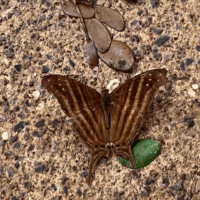Sauver les papillons
According to the latest IUCN update, there are over 178,000 species of butterflies and moths in the world, 18,000 species of butterflies and 160,000 species of moths, with wingspans ranging from 1 centimeter, of the Brephidium exilis[1] to 31 centimeters of the Ornithoptera alexandrae concerning butterflies, and from 3 centimeters of Nepticulidae to 31 centimeters of Attacus atlas concerning moths[2], they are part of the Lepidoptera order! Butterflies and moths live 30 days on average, but there are also butterflies and moths that only live for two days to some that can reach up to a year[3].
We are only aware of a small proportion of the species, and new species are being frequently discovered, however many face a multitude of threats which are leading many on a path towards extinction. Habitat loss is one of the leading causes of butterfly and moth species decline. A recent study published in the journal of Biological Conservation on 2019 estimates that butterfly populations suffered a decline of 53% in the last decade[4]. In 20 years for example, the population of the Western Monarch butterfly declined by 99.9%, and during their last great migration in 2020 only about 2000 individuals were found to have taken part, representing a miniscule 0.01% of the historic size.[5]
[1] Giulio Doremi Blog: https://gdoremi.altervista.org/blog/le-ali-piu-piccole-del-mondo-lepidotteri/
[2] Giulio Doremi Blog: https://gdoremi.altervista.org/blog/dimensioni-guinness-world-record-degli-insetti-simili/
[3] North America Butterfly Association: https://www.naba.org/qanda.html
[4] Biological Conservation journal: https://vajiramias.com/current-affairs/insect-population-decline/5c7228b01d5def712e4e05dd/
[5] Xerces Society: https://xerces.org/western-monarch-call-to-action
Global Census Butterflies Map
Thanks to your help, since the launch of the Global Butterflies’ Census in January 2021, we have receive 1500 pictures of butterflies and moths’ species, from 33 countries in the World.
Act now to save the butterflies
We should all appreciate the striking beauty and the of butterflies. And we should all act now to stop their decline. Friend of the Earth promotes products from sustainable agriculture thereby contributing directly towards butterfly conservation. And Friend of the Earth has now also launched the Global Butterfly Census, to promote education and their conservation by means of Citizen Science.
Anybody can now help Friend of the Earth assess global butterflies’ populations in two simple moves:
1. Take a close picture of the butterfly, avoiding disturbing it.
2. Send it to the WhatsApp number +39 351 2522520 or by the email info@friendoftheearth.org with your position coordinates.
Friend of the Earth will let you know the species’ name and some curiosities, and the info will be filed on an interactive map connected to our database. Thanks to your help, the information collected will aid producing internal statistics and to update existing scientific databases in the future. Furthermore, Friend of the Earth will be hosting a monthly award given to the ‘Butterflies Conservation Hero’ who will have provided the highest number of pictures, with a certificate of participation!
Anyone can contribute to the project by photographing butterflies spotted and sending photos via mail or WhatsApp
According to the International Union for Conservation of Nature (IUCN),Italy enjoys one of the highest concentration of butterfly varieties in Europe, with about 37% of the total species on the continent, second to Turkey which unfortunately is seeing 6.3% of its species at concerning extinction risk due to intensive agricultural practices and climate change.[6]
The World Sustainability Organization is committed to protecting the critical habitats of butterflies. Friend of the Earth certification standards, ensure that agricultural practices abide by evidence-based sustainable policy which permits agriculture whilst ensuring the least possible interference with local flora and fauna.
[6] Italian butterflies IUCN Red List: http://www.iucn.it/pdf/Comitato_IUCN_Lista_Rossa_delle_farfalle_italiane_2016.pdf
OUR COLLABORATIONS
POLYXENA ASSOCIATION
The Polyxena Association[7] operates in southern Italy for the conservation of biodiversity through research, education, and sustainable tourism. In June 2016, the association opened with the Farfalia, a butterfly house 90m2 in size that hosts 27 different species of butterflies that are common and on our territory.
An attempt was made to breed and reintroduce the Zerynthia polyxena, Melanargia arge and Hipparchia sbordonii species. Unfortunately, the undertaking has not yet been made possible, since in captivity these species don’t find the same balance that exists in their own habitat. Despite this, other species such as Cleopatra gonepteryx, Pieris rapae, Papilio machaon and Pieris brassicae, have completed their entire life cycle inside the house!
COLLODI BUTTERFLY HOUSE
The Collodi Butterfly House[8] is inhabited by hundreds of tropical colorful butterflies. They enjoy the climate-controlled house that represents the exact conditions felt in the tropical rain regions of their natural habitat. The structure offers educational courses and workshops for the little ones so that they can learn about the colorful life of this group of insects. Friend of the Earth has certified the Collodi Butterfly House as a structure capable of raising awareness on biodiversity, with a strong emphasis on animal welfare. The incentive has also proven fruitful in attracting critical awareness to the issue and bolstering the development of our Global Butterfly Census Program.
[7] Polyxena Association FB: https://www.facebook.com/apspolyxena
[8] Collodi Butterfly House: https://www.pinocchio.it/it/la-casa-delle-farfalle-di-collodi














